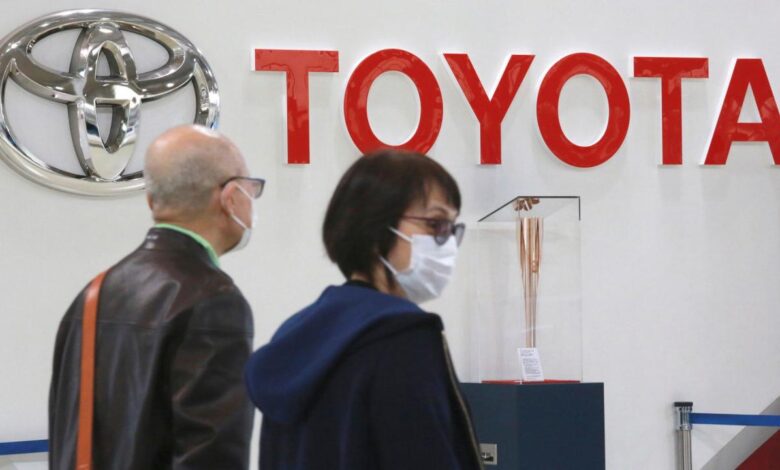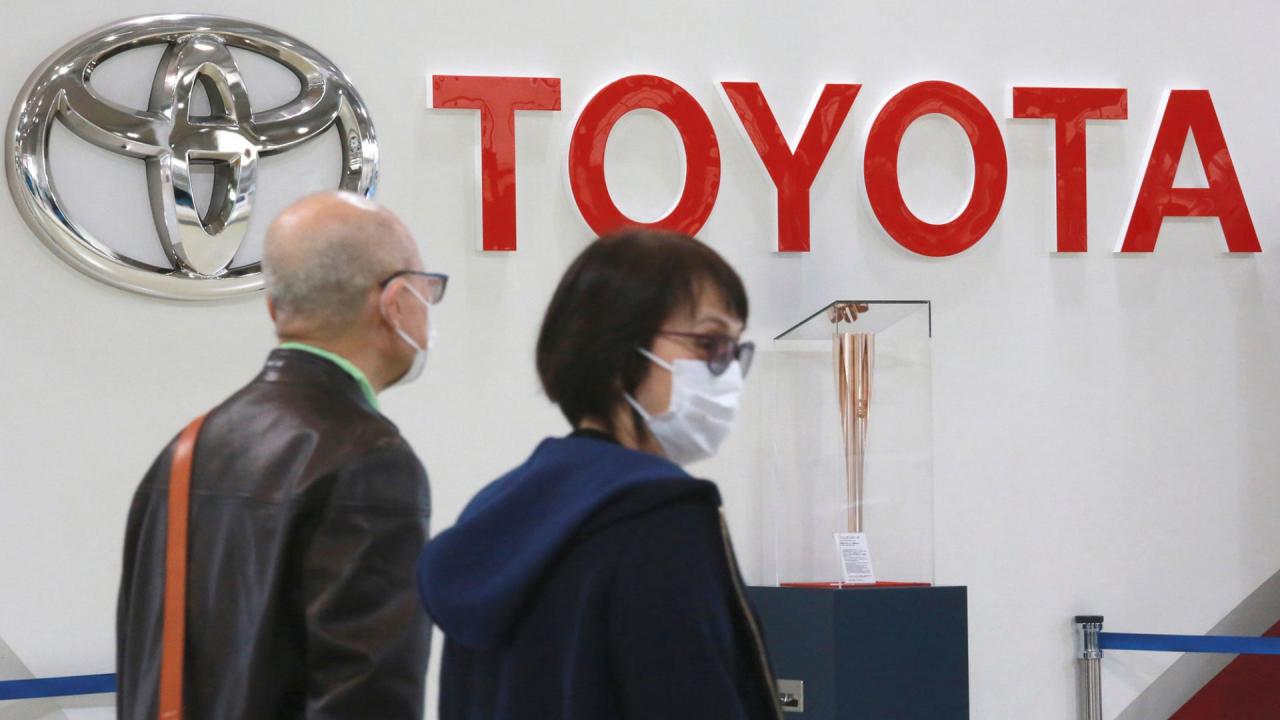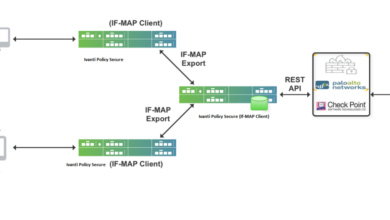
Cyber Attack on Toyota Car Maker A Deep Dive
Cyber attack on Toyota car maker – the very phrase conjures images of production lines grinding to a halt, sensitive data compromised, and a global giant brought to its knees. This isn’t just a hypothetical scenario; it’s a very real threat in today’s hyper-connected world. The automotive industry, with its increasingly sophisticated reliance on software and interconnected systems, presents a juicy target for cybercriminals, and Toyota, a leading manufacturer, is no exception.
This post explores the various ways Toyota could be vulnerable, the potential consequences of a successful attack, and what steps the company (and others) can take to mitigate the risk.
We’ll delve into the specific types of cyberattacks that could target Toyota, from ransomware to sophisticated exploits of connected car systems. We’ll also examine Toyota’s existing cybersecurity infrastructure, identifying potential weaknesses and proposing improvements. The potential impact on production, supply chains, and the company’s reputation will be analyzed, along with the necessary response and recovery strategies. Finally, we’ll walk through a hypothetical attack scenario to illustrate the real-world implications of this growing threat.
Types of Cyberattacks Targeting Toyota

The automotive industry, and Toyota in particular, is a prime target for cyberattacks due to its reliance on complex interconnected systems, from manufacturing plants to connected vehicles. These attacks can range from relatively simple attempts at data theft to sophisticated intrusions aiming to disrupt operations or even cause physical harm. Understanding the various attack vectors and their potential impact is crucial for effective cybersecurity strategies.
Common Cyberattack Vectors Against Automotive Manufacturers
Several common attack vectors threaten automotive manufacturers like Toyota. These include phishing campaigns targeting employees to gain access credentials, exploiting vulnerabilities in software used across the supply chain, and leveraging malware to infiltrate systems. External attacks often target vulnerable internet-facing systems, such as those controlling manufacturing processes or managing customer data. Internal threats, such as malicious insiders, also pose a significant risk.
The interconnected nature of modern automotive manufacturing and supply chains magnifies the potential damage from successful attacks, allowing attackers to move laterally across networks and systems.
Exploiting Vulnerabilities in Connected Car Systems
Sophisticated attacks can exploit vulnerabilities in connected car systems, compromising both individual vehicles and the broader network of vehicles and infrastructure. For instance, attackers might target over-the-air (OTA) update mechanisms, injecting malicious code into firmware updates. This could allow attackers to remotely control vehicle functions, potentially leading to safety hazards or data breaches. Furthermore, vulnerabilities in the telematics systems that collect and transmit vehicle data can provide access to sensitive information, including location data, driver behavior, and potentially even personal details stored within the car’s infotainment system.
A successful attack could enable large-scale surveillance or identity theft.
Impact of a Ransomware Attack on Toyota’s Manufacturing Processes
A ransomware attack on Toyota’s manufacturing processes could have devastating consequences. Encryption of critical systems could halt production lines, causing significant financial losses due to downtime and potential delays in fulfilling orders. The disruption could extend beyond Toyota’s own operations, impacting its suppliers and the broader automotive ecosystem. Restoring systems from backups might be time-consuming and costly, and there’s no guarantee that all data can be recovered without paying the ransom, which is often illegal and unethical.
The reputational damage from a successful ransomware attack could also be substantial, affecting consumer confidence and investor trust.
Effectiveness of Different Attack Methods Against Toyota’s Infrastructure
The effectiveness of different attack methods depends on various factors, including the sophistication of the attack, the security posture of Toyota’s infrastructure, and the attacker’s resources. Phishing attacks, while relatively simple to execute, can be surprisingly effective if employees are not adequately trained to identify and report suspicious emails. More sophisticated attacks, such as advanced persistent threats (APTs), might require more resources and expertise but can offer a greater degree of persistence and stealth, allowing attackers to remain undetected for extended periods.
The effectiveness of each method is also influenced by the specific vulnerabilities present in Toyota’s systems and networks.
Severity and Likelihood of Various Cyberattack Types
| Attack Type | Target | Impact | Likelihood |
|---|---|---|---|
| Phishing | Employees | Data breach, account compromise | High |
| Ransomware | Manufacturing systems, IT infrastructure | Production halt, data loss, financial losses | Medium |
| SQL Injection | Databases | Data breach, data manipulation | Medium |
| Denial-of-Service (DoS) | Websites, online services | Service disruption | High |
Toyota’s Cybersecurity Infrastructure

Toyota, a global automotive giant, possesses a complex cybersecurity infrastructure designed to protect its vast network of manufacturing plants, supply chains, research and development facilities, and increasingly, its connected vehicles. However, the scale of its operations and the interconnected nature of its systems present significant challenges in maintaining robust security.
Hypothetically, Toyota’s cybersecurity defenses likely involve multiple layers of protection. Network security would include firewalls, intrusion detection/prevention systems (IDS/IPS), and robust access control measures. Data protection would rely on encryption, data loss prevention (DLP) tools, and strict data governance policies. Incident response capabilities would involve a dedicated security team, pre-defined incident response plans, and potentially partnerships with external cybersecurity firms for advanced threat analysis and remediation.
However, the effectiveness of these measures is constantly challenged by evolving threats.
Potential Weaknesses in Toyota’s Security Architecture
Potential vulnerabilities could exist within Toyota’s legacy systems, which may lack the latest security patches and updates. The sheer size and complexity of its global network create challenges in maintaining consistent security policies and practices across all locations and systems. Furthermore, the increasing reliance on third-party suppliers and contractors introduces potential points of compromise. A successful attack could exploit vulnerabilities in these areas, potentially leading to data breaches, disruptions to manufacturing, or even compromising the safety of connected vehicles.
For example, a weakness in a legacy system controlling a manufacturing robot could allow attackers to disrupt production. A breach in a supplier’s network could expose sensitive design data or supply chain information.
Hypothetical Improved Cybersecurity Strategy
An enhanced cybersecurity strategy for Toyota should incorporate advanced threat detection techniques such as machine learning and artificial intelligence (AI) to identify and respond to sophisticated attacks in real-time. This would include implementing security information and event management (SIEM) systems to aggregate and analyze security logs from various sources. A robust vulnerability management program, incorporating automated vulnerability scanning and penetration testing, is crucial.
The implementation of a zero-trust security model, verifying every user and device before granting access to resources, would significantly enhance security. Toyota could also benefit from investing in blockchain technology to enhance the security and traceability of its supply chain. For instance, using blockchain to track parts throughout the manufacturing process could help prevent counterfeit components from entering the supply chain.
The Role of Employee Training and Awareness
Employee training and awareness are paramount in bolstering Toyota’s cybersecurity posture. Regular security awareness training should educate employees about phishing scams, social engineering tactics, and the importance of strong password hygiene. Simulations and phishing exercises can help identify vulnerabilities in employee awareness and reinforce best practices. A strong security culture, where employees feel empowered to report suspicious activity, is crucial for early threat detection and rapid response.
This proactive approach can minimize the impact of successful attacks.
Best Practices for Securing Connected Car Systems and Manufacturing Plants
Securing Toyota’s connected car systems requires implementing robust authentication and authorization mechanisms, secure over-the-air (OTA) update processes, and regular security audits. Data encryption, both in transit and at rest, is vital to protect sensitive vehicle data. For manufacturing plants, implementing industrial control system (ICS) security measures, including network segmentation, intrusion detection, and regular patching, is essential to prevent disruptions and safeguard critical infrastructure.
The recent cyberattack on Toyota, disrupting production and highlighting vulnerabilities in their systems, really got me thinking about robust security measures. It’s clear that comprehensive security is crucial, and learning about solutions like bitglass and the rise of cloud security posture management is essential. This kind of proactive approach could help prevent similar incidents from crippling major manufacturers like Toyota in the future.
Robust physical security measures, including access control systems and surveillance, should complement cybersecurity measures. Regular penetration testing of both connected car systems and manufacturing plant networks should be conducted to identify and address vulnerabilities before attackers can exploit them.
Impact of a Successful Cyberattack: Cyber Attack On Toyota Car Maker
A successful cyberattack on Toyota, a global automotive giant, would have cascading consequences across its operations, finances, and reputation, impacting not only the company itself but also its vast network of stakeholders. The scale of disruption would depend heavily on the nature and scope of the attack, but even a relatively contained incident could cause significant damage. The ramifications extend far beyond simple production delays, reaching into the legal arena and impacting consumer trust.The potential consequences are multifaceted and far-reaching.
Disrupting Toyota’s sophisticated manufacturing processes, for instance, could lead to significant production halts, impacting vehicle deliveries and ultimately, sales figures. A breach affecting the supply chain could cripple the timely acquisition of essential components, further exacerbating production issues and creating substantial financial losses. The financial impact would be immediate and potentially long-lasting, including lost revenue, increased operational costs associated with recovery, and potential legal settlements.
The recent cyber attack on Toyota highlights the vulnerability of even the biggest companies to sophisticated threats. Building robust security systems requires efficient and adaptable development, which is why I’ve been looking into the advancements in application development, like those described in this article on domino app dev, the low-code and pro-code future. Understanding these new approaches could be key to preventing future attacks like the one Toyota faced, strengthening overall digital resilience.
Production and Supply Chain Disruption
A cyberattack could severely disrupt Toyota’s Just-in-Time (JIT) manufacturing system, which relies on the precise and timely delivery of parts. Even a short-term shutdown of production lines due to a ransomware attack, for example, could result in millions of dollars in lost revenue daily. Compromised supply chain systems could lead to delays in receiving critical components, forcing production halts or even factory closures.
The ripple effect would be felt globally, potentially impacting dealerships and customers waiting for new vehicles. Consider the 2017 NotPetya ransomware attack, which significantly disrupted global supply chains and caused billions of dollars in damages across various industries – a similar attack on Toyota could have comparable, if not greater, repercussions.
Legal and Reputational Damage
Data breaches, a common outcome of cyberattacks, carry significant legal ramifications. Toyota could face hefty fines for non-compliance with data protection regulations like GDPR (General Data Protection Regulation) in Europe or CCPA (California Consumer Privacy Act) in the US. Furthermore, class-action lawsuits from customers whose personal data is compromised are highly likely. Beyond the legal costs, reputational damage could be equally devastating.
A loss of consumer trust, coupled with negative media coverage, could severely impact Toyota’s brand image and long-term sales. The Volkswagen emissions scandal serves as a stark reminder of the long-term impact reputational damage can have on a company’s value and market position.
Ripple Effect on Stakeholders
The impact of a cyberattack wouldn’t be confined to Toyota itself. Dealerships would experience disruptions in vehicle supply, leading to lost sales and potentially impacting their financial stability. Suppliers would face disruptions in their own operations, potentially impacting their relationships with other clients. The broader automotive industry could also be affected, as a major player like Toyota being compromised could trigger a wave of concern and increased cybersecurity spending across the sector.
Customers would face delays in receiving vehicles and could experience concerns about data privacy and security.
Economic Losses and Recovery Costs
The economic losses associated with a major cyberattack on Toyota would be substantial, encompassing direct costs like lost production, legal fees, and cybersecurity remediation, as well as indirect costs such as reputational damage and lost sales. Recovery efforts could take months, if not years, requiring significant investments in IT infrastructure, security personnel, and legal counsel. The total cost could easily run into hundreds of millions, or even billions, of dollars depending on the severity and scope of the incident.
The costs associated with restoring customer trust and rebuilding brand reputation would also be considerable and difficult to quantify.
Stakeholders and Their Concerns
The following list details the various stakeholders affected by a Toyota cyberattack and their respective primary concerns:
- Toyota: Financial losses, production downtime, legal liabilities, reputational damage, operational disruption.
- Customers: Data breaches, vehicle delivery delays, loss of trust in the brand.
- Dealerships: Vehicle supply shortages, lost sales, financial instability.
- Suppliers: Disruption of contracts, financial losses, operational delays.
- Investors: Stock price decline, loss of investment value, decreased company valuation.
- Employees: Job security concerns, potential data breaches affecting personal information.
- Government Regulators: Compliance violations, potential fines, consumer protection issues.
Response and Recovery Strategies
A swift and effective response is crucial for minimizing the damage from a cyberattack on a company the size and complexity of Toyota. A multi-layered approach, encompassing proactive security measures and a well-rehearsed incident response plan, is essential to ensure business continuity and protect sensitive data. The following details the steps Toyota should take to effectively manage a cyberattack.
Incident Detection and Response
Toyota needs a robust system for detecting malicious activity. This includes employing advanced threat detection tools, such as intrusion detection and prevention systems (IDPS), security information and event management (SIEM) systems, and endpoint detection and response (EDR) solutions. Regular security audits and vulnerability assessments are critical to identify and address weaknesses before they can be exploited. Furthermore, employee training on phishing awareness and safe computing practices is essential to prevent social engineering attacks.
A dedicated security operations center (SOC) staffed by experienced cybersecurity professionals should monitor these systems 24/7 to promptly identify and respond to any suspicious activity. Real-time threat intelligence feeds will provide crucial context and early warning signs.
Containment and Mitigation
Once a cyberattack is detected, immediate containment is paramount to prevent further damage. This involves isolating affected systems from the network to limit the spread of malware or ransomware. Toyota should have pre-defined procedures for disconnecting affected servers, workstations, and network segments. The next step is to identify the type of attack and the extent of the compromise.
This requires a thorough forensic investigation to determine the attacker’s methods, objectives, and the data that may have been compromised. Mitigation strategies will vary depending on the nature of the attack, but may include removing malware, patching vulnerabilities, and restoring data from backups. A critical component is to disable compromised accounts and implement strong access controls to prevent further unauthorized access.
System Restoration and Operational Recovery
After containment and mitigation, Toyota needs a comprehensive plan to restore its systems and operations. This begins with restoring data from reliable backups, ensuring data integrity and business continuity. A phased approach, starting with critical systems and gradually restoring less critical ones, is recommended. Toyota should regularly test its backup and recovery procedures to ensure their effectiveness.
The restoration process should also include a thorough security review to identify and address any remaining vulnerabilities. This may involve upgrading software, implementing new security controls, and retraining employees on updated security protocols.
Collaboration with External Entities
Effective response to a major cyberattack often requires collaboration with external experts. Toyota should have established relationships with law enforcement agencies (such as the FBI) and leading cybersecurity firms to ensure timely and effective support during an incident. Law enforcement can assist in investigating the attack, identifying the perpetrators, and pursuing legal action. Cybersecurity experts can provide specialized technical expertise in areas such as forensic analysis, incident response, and vulnerability remediation.
Open communication and information sharing are crucial for a coordinated response.
Incident Response Flowchart
- Incident Detection: Security systems detect suspicious activity (e.g., unusual network traffic, unauthorized access attempts).
- Initial Assessment: The SOC team analyzes the alert, determines the nature and scope of the incident.
- Containment: Affected systems are isolated from the network to prevent further damage.
- Eradication: Malware is removed, vulnerabilities are patched, and compromised accounts are disabled.
- Recovery: Systems and data are restored from backups, operations are resumed.
- Post-Incident Activity: A thorough review is conducted to identify lessons learned and improve future response capabilities. This includes updating security policies, procedures, and training programs.
- Collaboration: Engagement with law enforcement and external cybersecurity experts.
Illustrative Scenario: A Sophisticated Phishing Attack on Toyota
This scenario details a hypothetical, yet plausible, phishing attack targeting Toyota employees, resulting in a significant data breach. We’ll explore the attacker’s motives, methods, the compromised data, the consequences, Toyota’s response, and a glimpse into the deceptive nature of the phishing email.The attacker, a sophisticated cybercrime group motivated by financial gain and potentially industrial espionage, targeted Toyota’s vast network of employees.
Their goal was to obtain sensitive data, including intellectual property related to vehicle design, manufacturing processes, and customer data, which could be sold on the dark web or used for competitive advantage. The attack leveraged a highly targeted phishing campaign.
Attack Methodology
The attackers crafted a seemingly innocuous phishing email that mimicked an internal Toyota communication. The email appeared to be from a senior executive, requesting urgent action regarding a supposedly critical supply chain issue. The email’s subject line was compelling and urgent, something like “Urgent: Supply Chain Disruption – Immediate Action Required.” The email body was professionally written, using Toyota’s official branding and logo, including the executive’s signature.
It contained a link to a fraudulent website that mirrored Toyota’s internal portal. This site requested login credentials and other sensitive information under the guise of verifying employee access. Employees who clicked the link and entered their credentials unknowingly handed over their access to the company’s network. The attackers then used this access to move laterally within the network, ultimately gaining access to sensitive data repositories.
Compromised Data and Consequences
The breach compromised a significant amount of data, including design blueprints for upcoming vehicle models, proprietary manufacturing software, customer databases containing personal information (names, addresses, driver’s license numbers, and financial details), and internal communications revealing Toyota’s strategic plans. The exposure of this data could lead to significant financial losses, reputational damage, legal repercussions (potential lawsuits from affected customers), and a competitive disadvantage for Toyota.
Furthermore, the stolen intellectual property could be sold to competitors, giving them a significant advantage in the market.
Hypothetical Press Release
FOR IMMEDIATE RELEASEToyota Announces Data Security Incident[City, State] – [Date] – Toyota Motor Corporation today announced that it has experienced a data security incident affecting some of its systems. Upon discovering the incident, Toyota immediately launched an investigation with the assistance of leading cybersecurity experts. Preliminary findings indicate that unauthorized access was gained to certain company systems, resulting in the compromise of some employee and customer data.
Toyota is working diligently to understand the full extent of the breach and is taking steps to mitigate the impact on affected individuals. We are notifying affected individuals and providing them with support and resources. We deeply regret this incident and are committed to enhancing our security measures to prevent future occurrences. We are cooperating fully with law enforcement authorities.
Further updates will be provided as the investigation progresses.
Phishing Email Visual Description, Cyber attack on toyota car maker
The phishing email was meticulously designed to appear authentic. It used Toyota’s official logo and corporate color scheme. The sender’s email address was very similar to a legitimate Toyota executive’s email address, differing only by a single character or a slight alteration in the domain name. The email contained professional formatting and grammar, and the urgent tone and subject line aimed to create a sense of urgency and pressure on the recipient.
The link to the fraudulent website was subtly integrated into the text, appearing as a regular hyperlink. The overall visual presentation was designed to seamlessly blend with legitimate Toyota communications.
Ultimate Conclusion
The threat of a cyberattack on a major automaker like Toyota isn’t just a technical issue; it’s a matter of national security, economic stability, and consumer trust. While the specifics of Toyota’s internal security measures remain confidential, the vulnerability is clear. By understanding the potential attack vectors, the consequences of a breach, and the importance of robust cybersecurity strategies, we can better protect not only Toyota but the entire automotive industry from the increasingly sophisticated threats of the digital age.
The future of automotive manufacturing hinges on proactive and robust cybersecurity, and it’s a conversation we need to continue having.
Questions Often Asked
What kind of data could be compromised in a Toyota cyberattack?
A successful attack could expose a wide range of sensitive data, including customer information (names, addresses, financial details), design blueprints, intellectual property, supply chain data, and internal communications.
How could a cyberattack affect Toyota’s customers directly?
Customers could experience disruptions to connected car services, potential theft of personal data from their vehicles, and a loss of confidence in the brand.
What role does insurance play in mitigating the financial impact of a cyberattack on Toyota?
Cybersecurity insurance can help cover the costs associated with incident response, data recovery, legal fees, and potential business interruption following a successful attack.
What are some preventative measures Toyota could take beyond the usual security protocols?
Toyota could implement advanced threat intelligence, regularly conduct penetration testing and vulnerability assessments, and invest in AI-powered security solutions for early threat detection.





